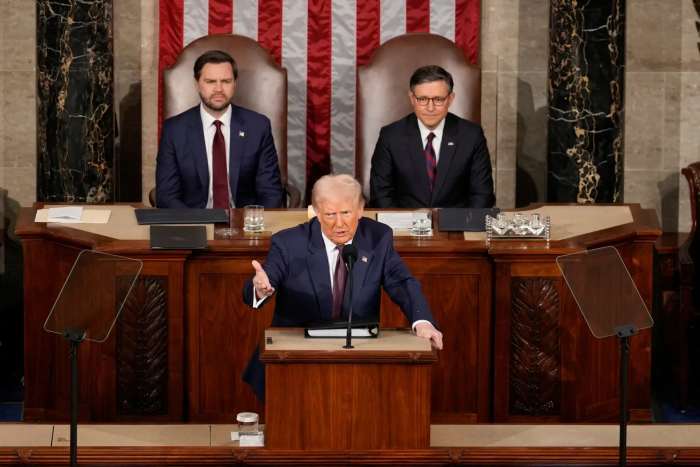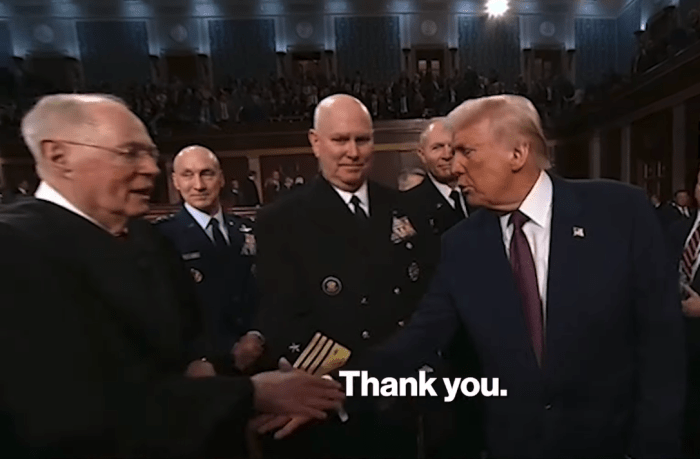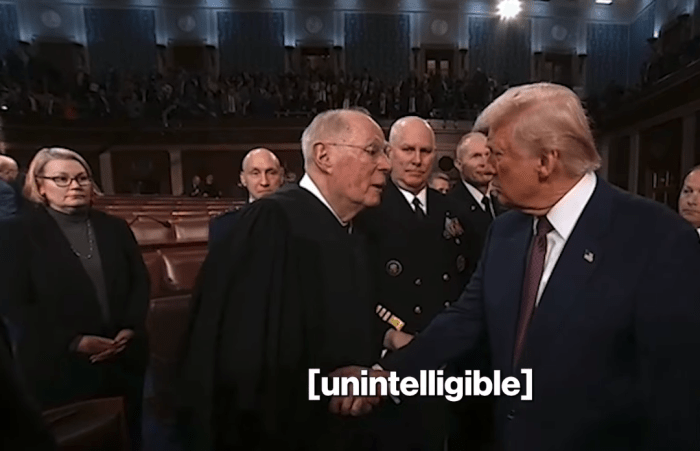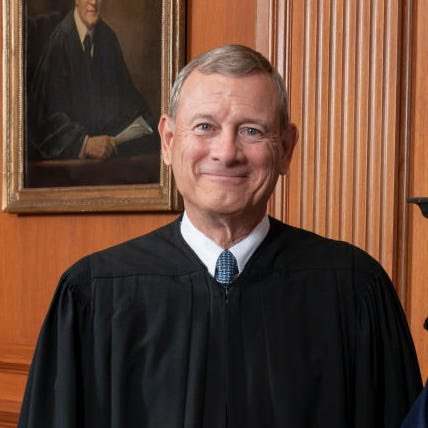Just hours after President Donald Trump was caught on a hot mic repeatedly thanking Chief Justice John Roberts, the Supreme Court’s top judge cast a decisive vote against the administration. The move immediately sparked speculation about the nature of Trump’s gratitude—and whether it was related to ongoing legal battles.
What Happened?
During Trump’s March 4 address to Congress, Supreme Court justices were in attendance, as is customary. As he made his way through the crowd, Trump shook hands with Roberts and was heard saying, “Thank you again. Thank you again. Won’t forget it.” The remark, captured by TV microphones, fueled immediate debate about what exactly Trump was thanking Roberts for.

President Donald Trump Vice President JD Vance and House Speaker Mike Johnson in congress, Photo Credit: Shadow Prince/X
The very next day, Roberts joined the court’s liberal justices in a 5-4 ruling blocking Trump’s attempt to withhold $2 billion in U.S. foreign aid. The ruling upheld a lower court decision by Washington, D.C. Judge Amir Ali, who had ruled against Trump’s executive order targeting the United States Agency for International Development (USAID).
Roberts and conservative Justice Amy Coney Barrett sided with the court’s three liberal justices—Sonia Sotomayor, Elena Kagan, and Ketanji Brown Jackson—to uphold the ruling. The decision dealt a significant blow to Trump’s agenda and immediately reframed the speculation surrounding Trump’s apparent appreciation for Roberts.
Was Trump Thanking Roberts for His Support?
The timing of Trump’s comments and Roberts’ vote led some commentators to suggest that the president had been acknowledging past Supreme Court decisions favorable to his administration.
An article from The Atlantic ran the headline “Why Trump Thanked John Roberts,” arguing that the Supreme Court’s conservative justices had often ruled in ways that benefited Trump’s presidency.
One major case often cited is Trump v. Anderson, in which the Supreme Court unanimously ruled that Trump could remain on the 2024 ballot. A group of Colorado activists had attempted to use the Fourteenth Amendment to disqualify him over claims he engaged in “insurrection” on January 6, 2021. The court’s ruling struck down the effort, allowing Trump to continue his campaign.

Chief Justice John Roberts with President Donald Trump shaking hands, Photo Credit: New York Post/Youtube
Trump Responds: ‘Fake News Never Quits’
As speculation swirled, Trump took to Truth Social to push back, claiming the media was fabricating a controversy.
“The Fake ‘Play the Ref’ News, in order to generate a divide between me and our great U.S. Supreme Court, heard me say last night, loudly and openly… ‘thank you’ to Chief Justice John Roberts,” Trump wrote.
Trump then clarified that his comments had nothing to do with legal decisions but were simply an acknowledgment of Roberts swearing him in as president on Inauguration Day, January 20, 2025.
“If Fake News CNN or MSDNC had just called the White House, I would have said to these sleazebag ‘journalists’ that I thanked him for SWEARING ME IN ON INAUGURATION DAY, AND DOING A REALLY GOOD JOB IN SO DOING!” Trump added, using his trademark nickname “MSDNC” to suggest MSNBC serves as a propaganda arm of the Democratic National Committee.

Chief Justice John Roberts with President Donald Trump shaking hands, Photo Credit: New York Post/Youtube
What’s Next?
With Roberts’ latest vote, tensions between the Trump administration and the judiciary are only expected to grow. At least ten federal judges have blocked or delayed Trump’s executive orders, and many of these cases are expected to reach the Supreme Court.
As the legal battles continue, the relationship between Trump and the nation’s highest court remains under intense scrutiny. The USAID ruling is just the latest in a series of high-stakes decisions that could shape Trump’s presidency—and his legacy.
Sources: Newsweek



